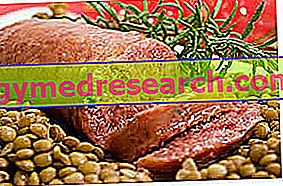NB : the following article will deal with "dry ciccioli" and not "fresh greaves or Neapolitan cracklings" food.

Generality and production
Greaves are a type of preserved pork ( S. scrofa domesticus ) characterized by a high energy intake due to its high lipid content. The greaves, in fact, are obtained from the remainder of the adipose tissue previously used in the extraction of lard.
- Perirenal fat which, pure and through special processing, becomes suet (indispensable for covering raw ham)
- Hard back fat
The greaves are therefore obtainable by extraction from lard coming from the back hard or, possibly, from other fatty cuts (see above); histologically, the greaves form the connective protein portion (instead of the perirenal fat) present in the subcutaneous adipose tissue .
As anticipated, the preparation of the cracklings is (at least initially) united to that of lard; start by separating the rind from the fat and cutting it into cubes. It is then necessary to proceed with cooking (long and sweet), which will eliminate the water of the fabric and dissolve the fats (mainly saturated); these, in liquid form, will be drained in special cooled containers (lard). The remaining solid portion, further squeezed by hand, is then salted and flavored (to varying degrees), going to constitute the greaves. The last step is the pressing; always properly placed in a cloth, the cracklings are placed in a press or, more traditionally, between two wooden or metal planks fitted with tie rods. At the end, the cracklings will have acquired the form of a single block that can be easily broken down by heat.
It is curious to learn which alternative methods the old butchers and the peasants studied for the production of the drier cracklings. Some, not satisfied with the home pressing, used to put the planks on the ground and park the tractor's rear wheels on it.
Use in the kitchen
| Nutritional composition of greaves - Reference values of the INRAN Food Composition Tables | ||||||||||||||||||||||||||||||||||||||||||||||||||||||||||||||||||||||||
 | ||||||||||||||||||||||||||||||||||||||||||||||||||||||||||||||||||||||||
Nutritional values (per 100 g of edible portion) | ||||||||||||||||||||||||||||||||||||||||||||||||||||||||||||||||||||||||
| ||||||||||||||||||||||||||||||||||||||||||||||||||||||||||||||||||||||||
Greaves, like cured meats, are consumed more frequently alone or accompanied with bread. On the other hand, there are numerous recipes that involve their use in cooking
Polenta with cracklings
One of the most well-known and appreciated is the " Polenta con i ciccioli ".
Ingredients
Corn flour, water for polenta, cracklings, onion, whole milk, butter, grated parmesan, salt.
Method
Prepare a polenta NOT pre-cooked following the traditional recipe; halfway through cooking, add a small quantity of milk and a knob of butter. When the end of cooking is finished, fry the chopped onion on a knob of butter, add the cracklings and let them soften. Combine the sauce thus obtained with the polenta, then pour it on a cutting board and let it cool. Slice the solidified polenta and sprinkle with grated Parmesan.
NB : the doses have NOT been deliberately mentioned as they are a poor process, typical of peasant housewives who, for their part, have never weighed anything (of course, the reduced consumption portions and the high level of physical activity typical of the time avoided any problem of overweight and metabolic imbalances associated with the richness in fats and calories of traditional dishes, today difficult to contextualize in the modern diet).
Nutritional characteristics
Greaves are a food of animal origin derived from the fatty tissue of the pig. Despite the fat extraction process, greaves are still a food rich in lipids, therefore high in calories and unsuitable for frequent consumption or low calorie diet in general. They are therefore not recommended for overweight or obese individuals. They are also unsuitable in the diet against hypercholesterolemia.
Although there is no detailed information on the breakdown of fatty acids, it is conceivable that the prevailing lipid portion of the cracklings is saturated and that the amount of cholesterol is very high.
Greaves are rich in high biological value proteins but (as already mentioned) this is not enough to justify their frequent consumption.
From a saline point of view, a good intake of iron and phosphorus is appreciated, while as far as vitamins are concerned, thiamine (vit. B1), riboflavin (vit B2) and niacin (vit. PP) are not lacking.



